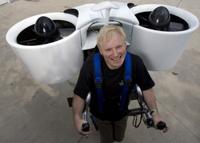-
ISC West goes hi-tech
This year Reed Exhibitions is going hi-tech for its ISC West security conference; the show’s organizers have developed a special mobile app and other technological changes to make this year’s show more convenient for attendees
-
-
FBI limits GPS tracking following Supreme Court case
Following the recent Supreme Court ruling that required law enforcement agencies to have a warrant before they could use GPS tracking devices on a suspect, the FBI has begun scaling back on its use of electronic surveillance
-
-
New handheld narcotics analyzer to help in war on drugs
The war on drugs must cope with new substances such as bath salts, one of many new designer drugs which reach the streets, so law enforcement technology must evolve as well
-
-
Thermal imaging proves useful for police
With the help of sophisticated new thermal imaging systems police officers around the United States have been able to apprehend criminals and locate car crash victims in perfect darkness without a hitch
-
-
Wireless underground robots for first responders
First responders may have to look for victims in hostile or challenging environments, such as clandestine tunnels, subway systems, and underground structures; sending a wireless robot to look around and pull victims out would be safer
-
-
Foul odor-blocking for first responders
First responders often find themselves working under unpleasant circumstances in places; a California company is offering first responders relief from at least one of these unpleasant exposures: offensive odor
-
-
Customizable crime alert map helps Louisville residents stay safe
With the help of sophisticated online mapping tools, residents in Louisville, Kentucky can receive customized updates on crime that can be narrowed down to a particular beat
-
-
Washington to test police gun safety equipment
Lawmakers in Washington are currently debating legislation that would require police departments to thoroughly test the gun locks and safes they issue to law enforcement officers for use in their homes
-
-
Recommended emergency response technology from Seattle’s CTO
Following the rare four-day snowstorm that left Seattle, Washington blanketed in snow, Bill Schrier, the city’s chief technology officer, weighed in on the city’s response and offered tips on how to better implement technology in the future
-
-
Smiths Detection unveils new portable chemical detector
Earlier this month Smiths Detection unveiled its latest chemical detector, a portable device that combines high speed, high-resolution gas chromatography and a miniaturized toroidal ion trap mass spectrometer
-
-
55 dog teams to sniff out explosives at Olympics
At the upcoming London Olympic Games, more than 150 bomb-sniffing dogs will be on hand to detect any potential threats
-
-
NYPD developing concealed gun detecting tech
The New York Police Department (NYPD) is currently at work on a device that can detect if a person is carrying a concealed firearm from as far as eighty-two feet away
-
-
N.J. city augments surveillance cameras with spotlights
Over the next three months, the East Orange police department will connect high-powered spotlights to their surveillance camera system, so that when camera operators spot suspicious activity they can turn on the bright lights of justice and deter would be criminals
-
-
First responders could be zipping through skies within two years

Glenn Martin, the inventor of the Martin Jetpack, the world’s first commercially available jetpack, recently spoke with Homeland Security NewsWire’s executive editor Eugene K. Chow; in their interview Martin discusses the technical challenges of developing a viable jetpack, its uses in emergency response, and when we can expect to see civilians zipping through the skies
-
-
GPS trackers help catch copper thieves
With thieves continuing to steal copper wiring and wreaking havoc on critical infrastructure systems across the United States, some security officials have taken to installing GPS tracking devices in copper wire to put an end to the growing problem
-
- All
- Regional
- Water
- Biometrics
- Borders/Immig
- Business
- Cybersecurity
- Detection
- Disasters
- Government
- Infrastructure
- International
- Public health
- Public Safety
- Communication interoperabillity
- Emergency services
- Emergency medical services
- Fire
- First response
- IEDs
- Law Enforcement
- Law Enforcement Technology
- Military technology
- Nonlethal weapons
- Nuclear weapons
- Personal protection equipment
- Police
- Notification /alert systems
- Situational awareness
- Weapons systems
- Sci-Tech
- Sector Reports
- Surveillance
- Transportation
Advertising & Marketing: advertise@newswirepubs.com
Editorial: editor@newswirepubs.com
General: info@newswirepubs.com
2010-2011 © News Wire Publications, LLC News Wire Publications, LLC
220 Old Country Road | Suite 200 | Mineola | New York | 11501
Permissions and Policies
Editorial: editor@newswirepubs.com
General: info@newswirepubs.com
2010-2011 © News Wire Publications, LLC News Wire Publications, LLC
220 Old Country Road | Suite 200 | Mineola | New York | 11501
Permissions and Policies
